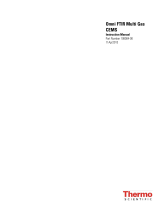
Nicolet RaptIR FTIRMicroscope
Site and Safety Guide
This manual contains a description of site requirements and a summary of the safety precautions
that must be followed when using a Thermo Scientific™ Nicolet™ RaptIR™ FTIR Microscope.
Using this instrument in a manner not specified in any of the documentation that came with the
instrument may create a hazardous condition. Each person who will be using, maintaining, or
servicing this instrument should read this manual.
For Research Use Only. This instrument or accessory is not a medical device and is not
intended to be used for the prevention, diagnosis, treatment or cure of disease.
Nicolet RaptIR FTIRMicroscope Site and Safety Guide 1
1.1Manual conventions 2
1.2Questions or concerns 3
1.3When the microscope arrives 4
2.Workspace requirements 5
2.1Microscope weight and dimensions 5
2.2Environmental factors 6
2.3Utility requirements 8
2.4Electrical requirements 9
2.5Liquid nitrogen 12
2.6Purging the microscope 12
3.Important safeguards 21
3.1Lifting or moving the instrument 21
3.2Plugging in the microscope 21
3.3Moving the stage or turret 21
3.4Using liquid nitrogen 22
3.5Choosing samples and solvents 22
3.6Selecting a purge gas 24
269-3504 00 Revision A
November 2021 ThermoFisher Scientific
All rights reserved.























